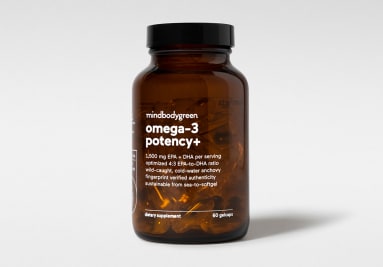How Many Times A Week Can You Eat Tuna? Here's The Limit To Stay Below
Here's how to enjoy seafood while keeping your mercury levels in check.


Registered Dietitian
Registered Dietitian
Jillian Kubala, MS, RD is a Registered Dietitian based in Westhampton, NY. She holds a master's degree in nutrition from Stony Brook University School of Medicine as well as an undergraduate degree in nutrition science.

Expert review by
Lauren Torrisi-Gorra, M.S., RD
Registered Dietitian
Lauren Torrisi-Gorra, MS, RD is a registered dietitian, chef, and writer with a love of science and passion for helping people create life-long healthy habits. She has a bachelor’s degree in Communication and Media Studies from Fordham University, a Grand Diplôme in Culinary Arts from the French Culinary Institute, and master's degree in Clinical Nutrition and Dietetics from New York University.
Image by Martí Sans / Stocksy June 22, 2023 Our editors have independently chosen the products listed on this page. If you purchase something mentioned in this article, we may From tuna sushi rolls to tuna sandwiches, tuna is as versatile a protein as they come. While all fish, including tuna, are a source of important nutrients, there are environmental and health-related concerns to consider when choosing tuna. Here's what to know about tuna's nutrition, health benefits, and how to safely consume it.
Advertisement
This ad is displayed using third party content and we do not control its accessibility features.
Types of tuna
Tuna is one of the most commonly consumed fish species in the world. In fact, canned tuna is the second most consumed seafood product in America, topped only by shrimp.
Most of the tuna found in canned products is skipjack tuna, which is the smallest and most plentiful type of commercial tuna species. Skipjack prefer warmer waters and are concentrated in tropical areas of the Atlantic, Pacific, and Indian Oceans. Albacore, also known as white tuna, is another tuna species commonly found in canned tuna products that are slightly larger than skipjack tuna. Albacore can be found in all ocean waters and the Mediterranean Sea.
Skipjack has a richer, more fishy taste compared to albacore, which has a lighter, more mild flavor. Ahi and yellowfin tuna are other mild-tasting tuna species often served raw as sashimi and cooked in steak form.
Summary
Skipjack tuna is the most plentiful and is often used in canned tuna. Known as white tuna, albacore is also a popular canned offering. Ahi and yellowfin are most commonly served as shashimi or steaks.
Advertisement
This ad is displayed using third party content and we do not control its accessibility features.
Nutrition
The nutrition of tuna products varies depending on the type. For example, tuna canned in oil is higher in calories and fat than fresh tuna and canned in water.
Here’s a nutritional breakdown1 of 1 can of albacore tuna canned in water:
Advertisement
This ad is displayed using third party content and we do not control its accessibility features.
“Tuna is high in protein, but low in calories and saturated fat,” functional nutritionist Barbara Sobel, MS, CNS, LDN points out to mindbodygreen. In addition to being low in calories and high in protein, tuna is rich in several vitamins and minerals, including B12 and selenium.
B122 is needed for vital processes such as neurological function, metabolism, and red blood cell formation, while selenium3 has antioxidant properties and is necessary for the production of thyroid hormones.
“Tuna also contains anti-inflammatory omega-3 fats4, although not as much as some of the fattier fish such as salmon, mackerel, and herring,” Sobel says.
Additionally, tuna is one of the few dietary sources of vitamin D, a fat-soluble vitamin that plays critical roles in immune function, bone health, and other vital bodily processes.
Fresh vs. packed or canned
All tuna products are rich in protein and relatively low in calories, but, because of its high fat content, tuna canned in oil is higher total calories5 compared to fresh tuna6 and tuna canned in water.
Many canned tuna brands use less expensive vegetable oils like soybean oil in their canned tuna products. However, it’s best to limit your intake of vegetable oils, like soybean and corn oil, and opt for healthier oils instead. If you’re shopping for tuna canned in oil, look for brands that use extra-virgin olive oil, which is more nutritious and less highly processed than cheaper alternatives.
Also, canned tuna, including tuna canned in water and tuna canned in oil, is much higher in sodium compared to fresh tuna due to the addition of salt during the canning process. If you’re sodium-sensitive, you may want to choose canned tuna with no-added salt, which can help cut back on your added salt intake.
Advertisement
This ad is displayed using third party content and we do not control its accessibility features.
Benefits
Eating seafood in general is linked to several health benefits, including improved cardiovascular health and protection against certain cancers. Plus, tuna provides a number of important nutrients, many of which are lacking in the average American diet. Here are a few potential health benefits linked to eating tuna:
1.
It may improve heart health.
Tuna is high in heart-protective nutrients, including anti-inflammatory omega-3 fats. These fatty acids boost heart health by promoting healthy blood vessel function, protecting against cellular damage, and encouraging healthy blood fat levels.
A review that included 34 meta-analyses 7found that each 100-gram-per-day increment in fish consumption was associated with a 12% lower risk of coronary heart disease7, a 25% lower risk of heart attack, and a 20% reduced risk of heart failure, on average.
Advertisement
This ad is displayed using third party content and we do not control its accessibility features.
2.
It may protect against certain cancers.
Studies show that people who follow healthy diets high in seafood have a lower risk of certain cancers. For example, the review mentioned above found that every 100-gram-per-day increase in fish consumption was associated with a 35% reduced risk of liver cancer7.
Another review found that compared to people who ate the least fish, people in the highest category of fish consumption had a significant 6% reduced risk of developing colorectal cancer8. In addition to the cancer-protective nutrients concentrated in seafood, the researchers postulated that this protective effect might be because people who eat more fish tend to eat less red and processed meat, which are strongly linked to colorectal cancer9.
3.
It's a source of vital nutrients.
Seafood is the main dietary source of the omega-3 fats DHA and EPA. Although your body can make DHA and EPA from ALA, which is found in plant-based foods like chia seeds, the conversion rate is poor. In fact, studies show that the conversion rate of ALA to EPA and DHA is between 7.0–21% and 0.01–1%10, respectively.
Because of this, the most effective way to maintain optimal levels of DHA and EPA is to eat foods rich in these fats, like seafood, or supplement with fish oil, krill oil, or algal oil, which is a plant-based source of DHA and EPA. In addition to omega-3s, tuna also provides nutrients like B12, iron, vitamin D, and selenium, which are lacking in many people’s diets.
4.
It may help support a healthy body weight
Tuna is rich in protein, the most filling macronutrient. Adding high-quality protein sources like tuna to meals and snacks can help you feel satisfied after eating, which can help you cut back on your overall calorie intake. This is why diets high in protein have been shown to be effective for weight loss.
Plus, following a high-protein diet preserves muscle mass11 when you’re losing weight, which can help you maintain a healthy resting metabolic rate or the calories your body burns while at rest.
5.
It may promote longevity.
People who follow diets rich in seafood tend to live longer than those who consume low amounts of seafood. According to findings from a recent study, eating more fish, as well as fruits and vegetables, has a substantial positive impact on life expectancy12. Fish intake has also been linked to a lower risk of death from all causes, including heart disease-related death.
The umbrella review discussed above found that each 100-gram-per-day increase in fish consumption was associated with an 8% lower risk of death from all causes7. (There's a reason fish is a mainstay in many longevity-focused Blue Zone diets.) Keep in mind that most studies investigating the health effects of seafood consumption focus on seafood intake in general, not specific types of fish, like tuna.
Also, even though tuna is nutritious, other types of fish, like sardines and mackerel, are more concentrated in certain nutrients, like omega-3s, and are largely considered more sustainable than tuna.
Concerns & side effects
There’s no arguing that tuna is nutritious, but many health and sustainability experts advise watching your intake of this popular fish for several reasons.
1.
It contains more mercury than other fish.
Certain fish are high in mercury, a heavy metal that’s readily taken up by the body. Mercury is a toxin that’s absorbed by fish through their gills as they swim and through their consumption of mercury-rich plankton. Larger fish tend to be higher in mercury than smaller fish. This is because larger fish consume large numbers of smaller fish that feed on mercury-containing plankton.
Generally speaking, the larger and older the fish, the higher the mercury levels.
Unfortunately, tuna is considered one of the most relevant dietary sources13 of mercury in the world. “Because tuna are higher on the food chain, they tend to retain more mercury in their fats,” climate-focused dietitian Dana Ellis Hunnes, PhD, MPH, RD, tells mindbodygreen. Hunnes explains that mercury is a known neurological disruptor14 and negatively affects the brain, especially in developing fetuses and in young children.
Keep in mind that the mercury in raw tuna is more bioavailable13 to your body than mercury found in cooked tuna, so people who frequently eat raw tuna products, like tuna sashimi, are at an increased risk of developing high mercury levels.
There are also sustainability concerns with fish that lie higher up the food chain, which we'll get to in detail below.
Lower-mercury options
Sardines and salmon are lower in mercury than salmon. Trout, haddock, shad, whiting, mullet, herring, and shellfish like shrimp, clams, and oysters are other examples of smaller, non-predatory fish that are low in mercury.
2.
Many fish are contaminated with microplastics.
Another downside to eating tuna, and any seafood for that matter, is that fish contains microplastics—small pieces of plastic less than 5 millimeters (.19 inches)15 in length found in marine environments like oceans and bays. “Eight million metric tons of plastics end up in the ocean each year from sources like discarded fishing nets and plastic trash, and the chemicals found in plastics bioaccumulate up the food chain,” says Hunnes.
Compounds present in microplastics16, including polybrominated diphenyl ethers (PBDE), bisphenol A (BPA), and nonylphenol (NP), are toxic and can be harmful to human health. Although more research is needed to fully understand how consuming foods that contain microplastics, like tuna, impacts our health, many experts, including Hunnes, suggest limiting your intake of microplastic-containing seafood, like tuna.
Tuna vs other fish
Here’s how tuna stacks up to other popular fish in terms of nutritional value, sustainability, taste, and price.
Sustainable purchasing
We won't sugarcoat it: Shopping for sustainable seafood can be challenging. “The seafood industry is complicated, international, and nuanced. People around the world rely on seafood for their nutrition and economic livelihoods. Yet, our oceans are being overfished and fishing is damaging sensitive habitats and polluting our waters,” says Sobel.
Plus, Sobel points out that you can't always trust what you read on a tuna label. “The word 'sustainable' is not an official certified designation. It does not mean anything specific and can be used by any company in any context,” she warns.
Fortunately, some areas have tight fishing regulations that ensure too many fish are not taken from the ocean at one time. Fishermen are also increasingly employing methods that result in less bycatch (AKA, fish that get caught but are not sold), such as pole-and-line catching.
While it's difficult to regulate such a vast industry, the Marine Stewardship Council (MSC) label applies to seafood products that have been certified to come from healthy stocks of fish. The Monterey Bay Aquarium Seafood Watch seafood recommendation search tool can also help you narrow down tuna species that are well-managed and caught or farmed in ways that cause less harm to the environment. Using these two tools is a good way to start shopping for more sustainable seafood.
mbg's picks for sustainable tuna
So, is it healthy?
Tuna is a nutrient-dense food, providing protein, essential fats, vitamins, and minerals. Moreover, diets rich in seafood have been linked to several health benefits, such as a reduced risk of common health conditions, like colorectal cancer and heart disease.
However, there are concerns related to mercury and microplastic accumulation in tuna as well as the environmental impact of the fishing industry. So, if you choose to eat tuna, it’s wise to limit your consumption to about one serving a week and choose sustainably-caught tuna products whenever possible.
How to eat tuna healthily
Many Americans are eating too much tuna, plain and simple. Studies show19 that mercury levels are quite high in both canned and raw tuna products and in order to prevent mercury accumulation, organizations like the Environmental Defense Fund recommend that adults limit their intake of canned white or albacore tuna to three times a month or less.
It is recommended that women who are pregnant further limit their intake of tuna, and choose low-mercury fish like the ones on this list from the FDA20.
To cut back on your consumption, swap tuna for smaller-sized fish that are less likely to accumulate high levels of mercury, such as salmon, mackerel, anchovies, herring, and sardines (S.M.A.S.H. fish). Eating a variety of seafood will help reduce your mercury intake and still reap the health benefits of fatty fish.
Frequently Asked Questions
Should you only eat tuna once a week?
The Environmental Defense Fund recommends that adults limit their intake of canned white or albacore tuna to three times a month or less. Canned light tuna (a mix of smaller tuna species) can be enjoyed up to once per week.
Is tuna better for you than chicken?
Tuna and chicken are both excellent sources of protein, but they have different nutrition profiles. Tuna is higher in certain nutrients, such as omega-3 fats, selenium, and B12, than chicken, while chicken is higher in others, like B6.
What are the tuna fish benefits and side effects?
Tuna is high in many essential nutrients, such as protein, omega-3 fats, selenium, and B12. However, it can contain high levels of mercury and is often contaminated with microplastics.
The takeaway
Tuna is a nutrient-dense protein, providing vitamins and minerals like B12 and selenium, plus omega-3 fats, which are lacking in many people’s diets.
Although studies show that diets rich in seafood may offer impressive benefits, these benefits must be weighed against the possible risks. It’s best to eat tuna in moderation and to mix more sustainable seafood choices such as sardines, anchovies, and herring into your diet too. And when you buy canned tuna, make sure it's packed in a healthy cooking oil.

 Koichiko
Koichiko 

































